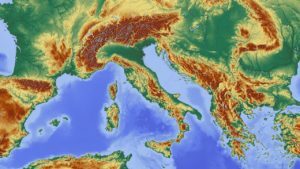
BMC (BIOMED CENTRAL)—Genetic adaptations of early Italian ancestors to environmental changes, such as those that occurred soon after the Last Glacial Maximum, may explain some of the genetic differences between northern and southern Italian populations today, according to a study published in BMC Biology. The research suggests that northern and southern Italian populations may have begun to diverge genetically as early as 19,000-12,000 years ago and constitutes the earliest known evidence of genetic divergence in Italy so far.
A team of researchers at the University of Bologna sequenced the genomes of 38 unrelated participants from different regions in Italy, each the third generation of their family native to each region. The genomes were selected as representative of known genetic differences across the Italian population and over 17 million distinct genetic variants were found between individuals. The authors compared these variations with existing genetic data from 35 populations across Europe and the Mediterranean and with variants previously observed in 559 ancient human remains, dating from the Upper Palaeolithic (approx. 40,000 years ago) to the Bronze Age (approx. 4,000 years ago).
Prof. Marco Sazzini, lead author of the study said: “When comparing sequences between modern and ancient genome samples, we found early genetic divergence between the ancestors of northern and southern Italian groups dating back to the Late Glacial, around 19,000-12,000 years ago. Migrations during the Neolithic and Bronze Age periods, thousands of years later, then further differentiated their gene pools. Divergence between these ancestral populations may have occurred as a result of temperature rises and subsequent shrinking of glaciers across Northern Italy during this time, allowing ancestors who survived the glaciation period to move north, separating from groups who remained in the south.”
Further analyses also revealed signatures ascribable to specific biological adaptations in northern and southern Italian genomes suggestive of habitation in differing climates. The genetic history of northern Italians showed changes in the genes responsible for regulating insulin, body-heat production and fat metabolism, whilst southern Italians showed adaptations in genes regulating the production of melanin and responses to pathogens.
Prof. Sazzini said: “Our findings suggest that the ancestors of northern Italians adapted to lower environmental temperatures and the related high-calorie diets by optimising their energy metabolism. This adaptation may play a role in the lower prevalence of Type 2 Diabetes recorded in Northern Italy today. Conversely, southern Italian ancestors adapted to a warmer climate with higher UV levels by increasing melanin production, which may explain the lower incidence rates of skin cancers recorded across Southern regions. The genomes of southern Italians also showed changes in the genes encoding mucins, which play a role in protection against pathogens, and genetic variants linked to a longer lifespan. Further research in this area may help us understand how the observed genetic differences can impact population health or predisposition to a number of diseases.”
The authors caution that although correlations may be drawn between evolutionary adaptations and current disease prevalence among populations, they are unable to prove causation, or rule out the possibility that more recent gene flow from populations exposed to diverse environmental conditions outside of Italy may have also contributed to the different genetic signatures seen between northern and southern Italians today.
______________________________

Hans, Pixabay
______________________________
Article Source: BMC (BIOMED CENTRAL) news release
______________________________
Advertisement




